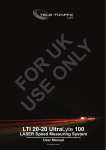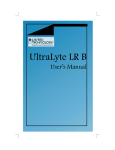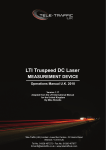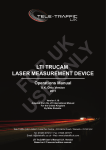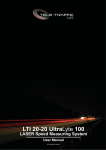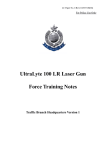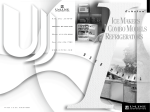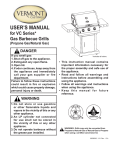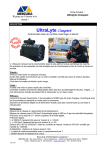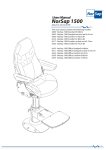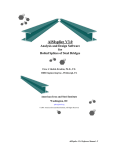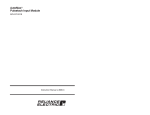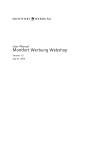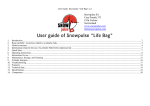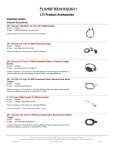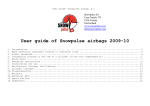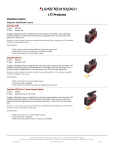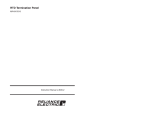Download LTI 20.20 UltraLyte 1000 Operations Manual - Tele
Transcript
LTI 20.20 UltraLyte 1000 Operations Manual © Tele-Traffic UK Ltd 2006 T Table of Contents 2S Safety Precautions 2 Section 1 – Getting Started 2 2 2 2 3 3 3 3 4 4 6 6 7 7 7 8 9 9 10 10 11 11 Unpacking Your UltraLyte 1000 UltraLyte 1000 Package Available Accessories About the UltraLyte 1000 Sensors LCD Screen Serial Port Connector Sighting Scope Button Panels Fold-Away Shoulder Stock Attaching the Yoke Inserting the Batteries Powering ON the UltraLyte 1000 Powering OFF the UltraLyte 1000 Extending the display Segment Test Understanding the Display Indicators Miscellaneous Display Features Adjusting the Aiming Dot’s Intensity Viewing the Firmware Revision Number Restoring the Factory Defaults Listening to the UltraLyte 1000 Understanding Error Conditions 12 Section 2 – Speed Measurements 12 13 13 13 14 15 15 Taking a Sample Measurement Choosing a Roadside Location Line of Sight The Cosine Effect Measuring a Moving Vehicle Jam Indicator Using the Weather Filter 17 Section 3 – Instrument Tests 17 17 17 18 19 19 Display Integrity Test Scope Alignment Scope Alignment Test Scope Alignment Procedure Instrument Confidence Check Fixed Distance Test 21 Section 4 – Maintenance 21 21 21 21 21 21 21 22 Section 5 - Serial Data Interface 22 22 22 22 23 Data Format Format Parameters Download Format Version ID requests Speed/Range Data Message Format 24 Section 6 – Specifications 25 Section 7 – Troubleshooting Tips 25 Operating Temperature Moisture and Dust Protection Shock Protection Cleaning and Storage Caring for the Scope Checking the Screen Display Resetting the Factory Default Settings Contact Details © Tele-Traffic UK Ltd 2006 Safety Precautions Avoid staring directly at the laser beam for prolonged periods. The UltraLyte 1000 is designed to meet IEC EN60825-1 standard and FDA eye safety requirements and is classified as eye-safe to Class 1 limits, which means that virtually no hazard is associated with directly viewing the laser output under normal conditions. As with any laser device, however, reasonable precautions should be taken in its operation. It is recommended that you avoid staring into the transmit aperture while firing the laser. The use of optical instruments with this product may increase eye hazard. Never attempt to view the sun through the scope. Looking at the sun through the scope may permanently damage your eyes. Never point the instrument directly at the sun. Exposing the lens system to direct sunlight, even for a brief period, may permanently damage the laser transmitter. Do not expose the instrument to extreme temperatures. o o UltraLyte 1000 components are rated for a temperature range of –30 C to +60 C. Do not expose the instrument to temperatures outside that range. Section 1 – Getting Started Tele Traffic’s UltraLyte 1000 is part of the UltraLyte family of handheld laser speed and ranging devices. Compared to the other UltraLyte models, the UltraLyte 1000: • Has simplified menus and options. • Includes a built-in Weather Filter that is an alternate speed measuring mode. The Weather Filter is a simplified UltraLyte gating option. This factory-defined gate ensures that targets are beyond the range where rain and snow can affect the laser’s ability to capture a speed reading. Other Features of the UltraLyte 1000 include: • • • • • • Liquid Crystal Display (LCD) screen for instant access to measurements and options. Serial output port for easy connection to a data collector or remote computer. Fully adjustable, fold-away shoulder stock. Sighting scope with in-scope red aiming dot and in-scope measurement display. Two 3-button panels that provide quick and easy access to the instrument display. Sounds and visual indicators that ensure confidence of positive target acquisition. Unpacking Your UltraLyte 1000 When you receive your UltraLyte 1000, check to make sure that you have received everything that you ordered, and that it all arrived undamaged. UltraLyte 1000 Package • • • • UltraLyte 1000 instrument Two C batteries User’s manual Carrying case Available Accessories You may have also ordered one or more of these optional accessories: • • • • • UltraLyte 2X Converter Upgrade UltraLyte Battery Eliminator Serial data cable (remote trigger optional) Yoke (includes adapter for monopod/tripod mounting) Monopod/Tripod 2 © Tele-Traffic UK Ltd 2006 About the UltraLyte 1000 Figure 1 shows the UltraLyte 1000’s front and rear panels. Sensors The UltraLyte 1000 has two lenses on the front panel. The top lens transmits the infrared laser signals. The bottom lens receives signals back from the target and feeds signal information to the internal circuitry. The internal circuitry consists of a laser range sensor and timing, analysis, computation and display circuits. The UltraLyte 1000 determines distance through its laser range sensor, by measuring the time of flight of short pulses of infrared light. The UltraLyte 1000 has a broad spectrum of sensitivity and can work with both reflective and non-reflective targets. The maximum measurements distance varies with target and environment conditions. The absolute maximum is about 1000 meters. LCD Screen The LCD Screen displays menu items, option indicators, error codes and speed measurement results. Serial Port Connector The serial port connector allows you to connect the instrument to a data collector or remote computer. For more information about the Serial Data Interface, see page 22. Sighting Scope Mounted on top of the UltraLyte 1000 is a single-power sighting scope. The scope features: • Adjustable polarizing light filter to optimize viewing contrast. Figure 2 shows the polarizing light filter’s adjustment ring. • In-scope red aiming dot to help you aim accurately to the target. • In-scope measurement display. Figure 3 shows the In-scope aiming dot. You can vary the intensity of the red dot to account for different lighting conditions. For more information, see page 9. Figure 2: Polarizing Light Filter 87 Figure 3: In-scope Aiming Dot 3 © Tele-Traffic UK Ltd 2006 Button Panels The UltraLyte 1000 has two, 3-button panels; one on each side of the instrument. The buttons provide easy access to the instrument functions. Table 1 lists the buttons and the functions of each. Left Panel Right Panel Table 1. Button Names and Functions Button Function SPEED MODE Activates the instrument’s speed measurement mode. WEATHER FILTER Activates the instrument’s alternate speed measurement mode. SURVEY MODE The UltraLyte 1000 does not include the Survey Mode. This button serves no purpose. TEST OPTIONS Activates the instrument’s test mode. SCOPE BRIGHTNESS Varies the intensity of the in-scope red aiming dot. BACKLIGHT POWER OFF Press and hold for 2.5 seconds: Powers OFF the instrument. This manual simplifies button names to relate to current function instead of matching the instrument’s label. For example: Button Names According to the Label. Press the BACKLIGHT POWER OFF button. Button Names in this Manual Press the BACKLIGHT button. -orPress the POWER OFF button Fold-Away Shoulder Stock The shoulder stock is fully adjustable, and is designed for either left-handed or right-handed use. Unfolding the Stock for Left-Handed Use Refer to the instructions and figure 4 below to unfold the stock for left-handed use. 1. Turn the tension knob counter-clockwise to loosen the stock. 2. Rotate the stock 180 degrees. 3. Turn the tension knob clockwise to retighten the stock. Figure 4: Unfolding the Shoulder Stock for Left-Handed Use 4 © Tele-Traffic UK Ltd 2006 Unfolding the Stock for Right-Handed Use Refer to the instructions and Figure 5 below to unfold the stock for right-handed use. 1. Hold the instrument firmly, and press down on the retaining plate with enough force to disengage the plate from the stock’s peg. 2. Pull the stock away from the body of the instrument and release the plate. 3. Rotate the stock to the right until the retainer peg re-engages. You should hear a loud click when the peg re-engages. Figure 5: Unfolding the Shoulder Stock for Right-Handed Use Adjusting the Length and Angle Refer to the instructions and Figure 6 below to adjust the stock’s length and angle. Length: 1. Loosen the tension knob. 2. Slide the stock back and forth to desired position. 3. Retighten the tension knob. Angle: 1. Loosen the tension knob slightly. 2. Move the stock up or down. Usually, it is best if the stock is at a slight downward angle. Figure 6: Adjusting the Shoulder Stock Refolding the Stock Refer to the instructions below to refold the stock. 1. Extend the stock to its full length. 2. Reverse the procedure that you used to open it (see above). Although the stock can be folded on either side, the UltraLyte 1000 only fits in its carry case when stock is fully extended and folded on the left side of the instrument. 5 © Tele-Traffic UK Ltd 2006 Attaching the Yoke The UltraLyte Yoke is an available accessory that allows you to mount the UltraLyte 1000 on a monopod or tripod. Refer to the instructions and Figure 7 below to attach the yoke to the UltraLyte 1000. The yoke can be mounted on either side of the instrument. When the yoke is mounted on the left side, the entire assembly fits into the padded carrying case. 1. Screw the mounting bracket and yoke adaptor into the mounting holes on the side of the instrument base. 2. Fit the yoke onto the mounting bracket. 3. Tighten the knob. Figure 7: Attaching the Yoke Adaptor and Yoke Inserting the Batteries Two C batteries are required to power the UltraLyte 1000. Refer to the instructions and Figure 8 below when inserting the batteries 1. 2. 3. 4. Remove the battery compartment cap by twisting counter clockwise. Insert the two batteries, positive end first, into the battery compartment in the instrument handle. Replace the cap. Twist the cap clockwise until it stops and its secure. Be careful to not over-tighten the cap. Figure 8: Inserting the Batteries 6 © Tele-Traffic UK Ltd 2006 Battery Voltage Level The UltraLyte 1000 continuously monitors it’s power source. Tele-Traffic UK has defined an acceptable battery voltage range to ensure that the instrument has sufficient voltage to guarantee correct operation. • The “BATT” display feature flashes on the screen if the battery voltage drops to the upper end of the acceptable battery voltage range. It continues to flash as long as battery voltage is within the acceptable range. You should replace the batteries as soon as possible. The display backlight is not accessible during low battery situations. • The “BATT” indicator stops flashing, and stays displayed on the screen if the battery voltage level drops below the acceptable battery voltage range. If you fail to replace the batteries, the button panels will lock out. Powering ON the UltraLyte 1000 To power ON the UltraLyte 1000: 1. Press the TRIGGER. Briefly, the screen display should look like Figure 9 below, and then the display will change to the Speed Measurement Screen. See figure 15 on page 12. Figure 9: LCD Display Segments Powering OFF the UltraLyte 1000 To power OFF the UltraLyte 1000: 1. Press and hold the POWER OFF button for approximately 2.5 seconds. To help save its batteries, the UltraLyte 1000 has a factory-defined power OFF interval. The instrument will automatically power OFF if there is no activity for a period of 15 minutes. Instrument activity includes any button presses or serial communication. Extending the Display Segment Test Extending the Display Segment Test lets you confirm that all display indicators are working. Refer to the instructions below to extend the display segment test. 1. With the UltraLyte 1000 powered OFF, press and hold the TRIGGER. 2. Refer to Figure 9 (above) to ensure that all of the display segments are showing on your UltraLyte 1000. 3. Release the TRIGGER. Upon release of the TRIGGER, the display will change to the Speed Measurement Screen. See Figure 15 on page 12. If you need assistance, contact Tele-Traffic UK. See page 25 for Tele Traffic UK contact information. 7 © Tele-Traffic UK Ltd 2006 Understanding the Display Indicators Table 2 lists the display indictors and the function of each. The indictors appear in order of location on the display, from left to right starting in the upper left corner. See Figure 9 on page 7. Table 2. Display Indictors Display Indicator Function Display Backlight Explanation Visible – The LED backlight is ON. Not Visible - The LED backlight is OFF. MENU Options Menu LASER Laser Fire BATT Battery This feature is not available on the UltraLyte 1000. The instrument’s laser is firing. Flashing – Battery voltage is low. Steady – Battery voltage is too low. Power OFF the instrument. Not Visible – Battery voltage is within the factory defined acceptable range. Upper Display Provides access to speed measurements and messages. MPH KmH CmS Speed Units MPH – Miles per Hour KmH - This feature is not available on the UltraLyte 1000. CmS - This feature is not available on the UltraLyte 1000. JAM Jam Detection GSL Gate Short Long TOD Time Over Distance This feature is not available on the UltraLyte 1000. CONT Continuous Mode This feature is not available on the UltraLyte 1000. Indicates Jamming Signal. When the instrument’s Weather Filter is active, the “GS” indictor is displayed. This is an alternate speed measurement mode that includes a factory-defined gate setting. Speed Mode The instrument’s Speed Mode is active. Survey Mode This feature is not available on the UltraLyte 1000. TEST Test Mode DBC Distance Between Cars This feature is not available on the UltraLyte 1000. DELTA Distance Difference This feature is not available on the UltraLyte 1000. MUTE Mute (silent) Mode This feature is not available on the UltraLyte 1000. Survey Icon This feature is not available on the UltraLyte 1000. Lower Display The instrument’s Test Mode is active. Provides access to range measurements and messages. FM Distances Units S Time Units This feature is not available on the UltraLyte 1000. DG Inclination Units This feature is not available on the UltraLyte 1000. V Power Units This feature is not available on the UltraLyte 1000. F - This feature is not available on the UltraLyte 1000. M – Meters 8 © Tele-Traffic UK Ltd 2006 Miscellaneous Display Features Table 3 lists the miscellaneous display features that are not part of the Display Segment Test: Table 3. Miscellaneous Display Features Display Feature br xx Explanation Refer to Pages The in-scope red aiming dot’s intensity setting. 9 When restoring factory defaults, indicates that the task was completed. 10 When the Speed Mode is active, indicates that the Weather Filter is OFF. 12 dEF The instrument is restoring the factory defaults. 10 Exx Error Code. An error condition has occurred during a measurement or in the system hardware. 11 FiLtEr Appears at the bottom of the screen when the instrument’s Weather Filter is toggled ON. 15 tt The instrument’s test tone is active. Used during the Scope Alignment Test and Procedure. 17-18 CLEAr Adjusting the Aiming Dot’s Intensity The in-scope red aiming dot has eight intensity settings from OFF (00) to BRIGHT (07). Refer to the instructions and Figure 10 below to adjust the red aiming dot’s intensity. 1. Press the SCOPE BRIGHTNESS button. The display should look similar to Figure 10. The current setting is whatever “br xx” is displayed. The factory default setting is “br 05” as shown in the figure. Figure 10: Aiming Dot Intensity Setting 2. Press the SCOPE BRIGHTNESS button until the setting is correct. It’s easy to get the correct setting if you look through the scope while making the adjustment. 3. Press the TRIGGER to the measuring mode that was most recently active . Otherwise, press the button that corresponds with whatever it is that you want to do next. For more information, see Table 2 on page 8. • • • Each time you press the SCOPE BRIGHTNESS button, the “br xx” value increases by 1. If you press the SCOPE BRIGHTNESS button while “br 07” is displayed, you will see “br 00” next. Powering OFF the instrument does not change this setting. The next time the instrument is powered ON, the setting will be the same. 9 © Tele-Traffic UK Ltd 2006 Viewing the Firmware Revision Number Firmware is the internal software that controls how the UltraLyte 1000 works. The firmware revision number provides manufacturing information about your UltraLyte 1000. It can only be viewed at power ON. Refer to the instructions below to view the firmware revision number. 1. With the UltraLyte 1000 powered OFF, press and hold the TRIGGER. 2. Press the SURVEY MODE button. The display should look similar to Figure 11. 3. Release the SURVEY MODE button. Figure 11: Mode and Firmware Revision In this example: • • • • • 100 is the model number. 3.03 is the software revision number. MPH (miles per hour) is the factory default speed unit. M (metres) is the factory default range unit. D (degrees) is the factory default angular unit. 4. Release the TRIGGER. Display will change to the Speed Measurement Screen, see figure 15 on page 12. For further reference, note the firmware revision number here: Restoring the Factory Defaults The UltraLyte 1000 has one user-selectable option – the in-scope aiming dot’s intensity. Although, you may never need to, you can restore the instrument’s factory settings. Refer to the instructions and Figures 12 and 13 below to restore the factory default for the in-scope aiming dot’s intensity. 1. With the UltraLyte 1000 powered OFF, press and hold the TRIGGER. 2. Press and hold the BACKLIGHT button. The display should look like Figure 12. 3. Continue to hold the TRIGGER and the BACKLIGHT button until the CLEAR indicator is displayed as Figure 13 shows. 4. Release the TRIGGER and the BACKLIGHT button. The display will change to the Speed Measurement Screen, see Figure 15 on page 12. Figure 12: Restoring the Factory Defaults Figure 13: Factory Defaults Restored 10 © Tele-Traffic UK Ltd 2006 Listening to the UltraLyte 1000 The UltraLyte 1000 emits a variety of beeps and tones during use. The sounds vary and depend on what the instrument is doing. With experience, you will be able to tell what is happening simply by listening. Table 4 lists and explains each of the sounds. Table 4. Sounds and What They Mean Sound Explanation High-Pitched Beep The instrument successfully completed the intended speed measurement. Double High-Pitched Beep At power ON. Single Low-Pitched Beep The instrument was not able to take the intended measurement due to an error. An error code is displayed to indicate the nature of the error. Low-Pitched Growl The instrument is attempting to lock onto a target. High-Pitched Oscillating Ring Jam tone. The instrument’s laser return sensor is being overwhelmed by light. Understanding Error Conditions Error conditions can occur in a measurement or in the system hardware. To make sure that you do not get an erroneous speed reading, the UltraLyte 1000 monitors both the system hardware and the measurement. When the instrument detects an error condition, it displays an error code instead of a measurement. Error codes are in the form “Exx”, where “xx” is an error code number. Figure 14 shows an E03 error code, Measurement error – unstable targeting. Figure 14: Sample Error Code Display Error Codes Table 5 lists and explains each of the possible error codes. Table 5. Error Codes and What They Mean Code Explanation doF Display overflow. The measurement exceeds the display capacity. It is possible to receive a doF message in the scope and still have a valid measurement display on the screen. E01 Measurement error – target never acquired. The target was out of range or was too close. E02 Measurement error – insufficient data. The instrument’s view was obstructed or the target moved out of range. E03 Measurement error – unstable targeting. Caused by poor aiming or by panning off the target. Measurement error – low level of interference from a light source such as a headlight or a laser jamming device. E07 Jam Detect – high level of interference from a light source such as a headlight or laser jamming device. E52 Temperature too cold. Stop operation. E53 Temperature too hot. Stop operation. E54 E55 E56 E60 E61 E62 E63 Calibration or memory checksum failure. If the error persists, contact Tele-Traffic UK Ltd. See page 25 for Tele-Traffic UK contact information. 11 © Tele-Traffic UK Ltd 2006 RFI Considerations The UltraLyte 1000 does not display a specific error message indicating the presence of radio frequency interference (RFI). The instrument’s electronics have been designed for optimum RFI immunity. If RFI is present, the instrument displays an error code. The exact code depends on the level and nature of the RFI. Section 2 – Speed Measurements When you power ON the UltraLyte 1000, the screen display should look similar to Figure 15. Figure 15: Initial Speed Measurement Screen Taking a Sample Measurement Refer to the instructions below to take a sample speed measurement. 1. Ensure that the UltraLyte 1000 is powered ON and that the Speed Mode is active. 2. Use the sighting scope to aim the instrument to a convenient target – an interior wall will do. 3. Fire the laser: • Press and hold the TRIGGER. The laser will fire after a short delay (about one-half of a second). -or • Press the TRIGGER twice. The 1st press turns on the in-scope red aiming dot. The 2nd press takes the measurement. 4. Continue to press the TRIGGER and keep the instrument sighted on the target: • A low-pitched growl means that the instrument is attempting to lock onto the target. • A low-pitched beep means that a measurement error occurred. An error code will be displayed. • A high-pitched beep means that a speed was captured. The measured speed will be displayed on the LCD screen and will be projected on the scope, just below the aiming dot. After you release the TRIGGER the instrument will display the speed reading and the distance at which it was captured or an error code. When the speed reading is displayed, the display screen will look similar to Figure 16. Figure 16: Sample Speed Measurement – Wall 12 © Tele-Traffic UK Ltd 2006 Choosing a Roadside Location When choosing a spot on the side of the road for measuring moving vehicles, you will need to consider the following: • • • • Do you have a clear line of sight? What is the approximate angle between the instrument’s position and the target vehicle’s direction of travel? What is the approximate distance to the target vehicles? How is the weather? Will you need to use the Weather Filter? Line of Sight Ideally, you should have a clear line of sight to the target vehicle. However, if there is a break in the beam, the instrument may be able to accumulate enough data to capture the target vehicle’s speed. • If there is a momentary break in the beam, the instrument will accumulate data and may be able to capture the target vehicle’s speed. The instrument will display an error code if it cannot capture the target vehicle’s speed. • If there is an extended break in the beam, the instrument will display an error code. The Cosine Effect If the target vehicle is moving directly toward or away from you, the speed measured by the UltraLyte 1000 is identical to the vehicle’s true speed. However, the instrument is usually set up on the side of the road for safety. This results in an angle between the instrument’s position and the target vehicle’s direction of travel. When the angle is significant, the measured speed is less than the target’s true speed. The phenomenon is known as the cosine effect. Cosine is the trigonometric function that relates to this phenomenon. The difference between the measured speed and the true speed depends upon the angle between the instrument’s ideal position – the position where targets would be moving in direct line with the instrument – and it’s actual position. • • • The larger the angle, the lower the measured speed. The effect always works to the motorist’s advantage. Loosely speaking, the cosine effect is not significant as long as the angle remains small. Table 6 shows this effect. Table 6. Measured Speed by Angle: The Cosine Effect Angle (degrees) True Speed 30 mph 40 mph 50 mph 60 mph 70 mph Measured Speed (mph) 0 30.00 40.00 50.00 60.00 70.00 1 29.99 39.99 49.99 59.99 69.99 3 29.96 39.94 49.93 59.92 69.90 5 29.89 39.85 49.81 59.77 69.73 10 29.54 39.39 49.24 59.09 68.94 15 28.98 38.64 48.30 57.94 67.61 20 28.19 37.59 46.99 56.38 65.78 45 21.21 28.28 35.36 42.43 49.50 90 00.00 00.00 00.00 00.00 00.00 The cosine effect decreases as the range to the target vehicle increases. • At the maximum range of the instrument, the vehicle is so far away that the angle between it and the instrument is very small indeed. The instrument’s perception of the target’s speed is identical to its true speed. • As the vehicle approaches, the angle increases until it becomes large enough to affect the measurement. To minimize the cosine effect, keep the angle small. Set up the instrument as close to the road as possible without creating safety risks and target down the road at ranges sufficient to keep the angular difference small. 13 © Tele-Traffic UK Ltd 2006 Table 7 shows acceptable parameters for minimizing the cosine effect. The chart indicates the percentage of true speed measured, given the distance from the roadway and the distance from the target vehicle. To find a target’s measured speed, multiply the true speed by the number in the chart Table 7. Percentage of True Speed Measured Distance off the Roadway (meters) Range to Target Vehicle 30 m 100 m 150 m 300 m 600 m fraction of true speeed that will be measured 3 .9950 .9995 .9998 .9999 1.0000 10 .9682 .9950 .9987 .9997 .9999 15 .8660 .9886 .9950 .9987 .9997 30 .0000 .9539 .9789 .9950 .9987 60 .0000 .7999 .9165 .9798 .9950 The diagonal created by the boldface numbers indicates the boundary between acceptable and unacceptable parameters. • Numbers above the diagonal are acceptable margins of error. • Numbers below the diagonal are unacceptable margins of error. Remember that the cosine effect is always in the motorist’s favour. As a general rule, do not exceed 1 meter off the road for every 10 meters shooting down range to the targets. If target vehicles will be 150 meters down the road, set up no more that 15 meters off the road. Measuring a Moving Vehicle Refer to the instructions below to use the UltraLyte 1000 to measure the speed of a moving vehicle. 1.Ensure that the UltraLyte 1000 is powered ON and that the Speed Mode is active. 2.Use the sighting scope to aim the instrument at the target’s vehicle’s license plate area and press the TRIGGER. 3.Continue to press the TRIGGER and keep the instrument sighted on the target. • A low-pitched growl means that the instrument is attempting to lock onto the target • A low-pitched beep means that a measurement error occurred. An error code will be displayed. • A high-pitched beep means that a speed was captured. The measured speed will be displayed on the LCD screen and will be projected on the scope, just below the aiming dot. While the instrument is attempting to lock onto the target , as long as the TRIGGER is kept pressed, it will retry the speed measurement. • Depending upon it’s configuration, the instrument will try to 10 times or more. Information is accumulated until it gets a good measurement or generates an error code. • Consequently, it is very important that the aiming point on the target remain constant for the entire measurement time. If you move the instrument off the aiming point, it will generate an error code instead of capturing a speed reading. After you release the TRIGGER the instrument will display the speed reading and the distance at which it was captured or an error code. When the speed reading is displayed, the display screen will look similar to Figure 17. Figure 17: Sample Speed Measurement – Departing Vehicle • The speed displays as a negative number if the target was going away from you when it was measured. • The speed displays as a positive number if the target was approaching you when it was measured. 14 © Tele-Traffic UK Ltd 2006 Jam Indicator The JAM display indicator (page 8) on the back panel screen may blink during a measurement and may be accompanied by the jam tone (page 11). This indicates that the instrument is being flooded by light and is having difficulty detecting its own signal. There are two possible situations: • You are targeting a strong light source such as headlights. -or• A targeted vehicle is employing a laser jamming device. Regardless of the level of interference, you will never get an erroneous speed reading. • At a low level of interference, a speed may be captured or an E03 error code may be displayed. • At a high level of interference, an E07 error code will be displayed. Using the Weather Filter Moisture is reflective. Weather such as rain, snow, or fog can make if difficult for the laser to receive signals back from the target. This is especially true when you are trying to capture speeds at a close range. The UltraLyte1000 includes a built-in Weather Filter that is an alternate speed measurement mode. When the Weather Filter is active, the factory-defined gate setting increases the instrument’s minimum range from 20 meters to 61 meters. Increasing the minimum range ensures that the laser only acquires targets beyond the range where weather affects the laser’s ability to capture a speed reading. When the Weather Filter is active: • • • • • The “SPEED” indictor is displayed. The “GS” indictor appears on the screen and word “FiLtEr” appears at the bottom of the display screen until it is overwritten by the distance to the target vehicle when a speed measurement is completed. Targets must be a distance greater than 61 meters. The instrument’s maximum range is not changed. Other than the above items, the UltraLyte 1000 operates the same as when the Speed Mode is active and the Weather Filter is OFF (see page 12). Refer to the instructions and Figure 18 below to activate the Weather Filter. 1. Ensure that the UltraLyte 1000 is powered ON. 2. Press the WEATHER FILTER button. The display should look similar to Figure 18. Figure 18: Initial Screen When the Weather Filter is Active 3. Aim the instrument at the target vehicle’s license plate area and press the TRIGGER. A low-pitched growl begins, indicating the instrument is trying to acquire a lock on the target. 4. Continue to press the TRIGGER and keep the instrument sighted on the target. • • A low-pitched growl means that the instrument is attempting to lock onto the target. A low-pitched beep means that a measurement error occurred. An error code will be displayed. A high-pitched beep means that a speed was captured. As long as you hold the TRIGGER, the instrument will continue to take speed measurements. The measured speed will be displayed on the LCD screen and will be projected on the scope, just below the aiming dot. While the instrument is attempting to lock onto the target, as long as the TRIGGER is kept pressed, it will retry the speed measurement. • • Depending upon its configuration, the instrument will try up to 10 times or more. Information is accumulated until it gets a good measurement or generates an error code. Consequently, it is very important that the aiming point on the target remain constant for the entire measurement time. If you move the instrument off the aiming point, it will generate an error code instead of capturing a speed reading. 15 © Tele-Traffic UK Ltd 2006 After you release the TRIGGER the instrument will display the most recent speed reading and the distance at which it was captured or an error code. When the most recent speed reading is displayed, the display screen will look similar to Figure 19. Figure 19: Sample Speed Measurement – Weather Filter ON When the Weather Filter is activated, the word “FiLtEr” appears at the bottom of the display screen. Once a successful speed measurement is completed, the distance measurement overwrites this part of the display. The “GS” display feature appears on the screen until the Weather Filter is no longer active. 16 © Tele-Traffic UK Ltd 2006 Section 3 – Instrument Tests There are three tests that allow you to verify the UltraLyte 1000’s mechanics. These tests include: • Display Integrity Test • Scope Alignment Test • Fixed Distance Test Display Integrity Test The Display Integrity Test allows you to verify that all display segments are operating. Tele-Traffic UK suggests that you do this test periodically. Refer to the instructions and Figure 23 below to test the display integrity. 1. Ensure that the UltraLyte 1000 is powered ON. 2. Press the TEST OPTIONS button. The display should look like Figure 20. Figure 20: Display Integrity Test 3. Compare the instrument’s display to the figure above. If any segment fails to display, contact Tele-Traffic UK Ltd, to arrange for repair. See page 25 for the Tele-Traffic UK contact information. You may also test the display integrity at power ON, by holding the TRIGGER (see page 7). Scope Alignment The scope alignment is set at the factory when the instrument is shipped. A heavy blow is the only reason that the scope might ever go out of alignment. This section includes the Scope Alignment Test and the Scope Alignment Procedure. Tele-Traffic UK suggests that you do this test periodically. The scope Alignment Procedure will only be necessary if the Scope Alignment Test shows that the scope is out of alignment. Scope Alignment Test This test uses sound to indicate when the scope is on-target. Refer to the instructions below to do the Scope Alignment Test. 1. 2. 3. Select a target. Choose a prominent target with well-defined horizontal and vertical edges. The target’s reflective qualities and distance should be such that you can clearly hear a change in pitch of the test tone as you pan the instrument over the edges of the target. A telephone pole is an excellent choice. Make sure there is nothing behind the target that the instrument might detect, so you know without a doubt that any change in pitch is due strictly to the target. Ensure that the UltraLyte 1000 is powered ON. Press the TEST OPTIONS button twice to activate the Test Tone display screen. It should look like Figure 21. Figure 21: Test Tone Display Screen 17 © Tele-Traffic UK Ltd 2006 4. Scan the target. Press and hold the TRIGGER while panning the instrument across the target. The tone changes pitch when the instrument acquires the target. The highest-pitch – the on-target tone – should occur when the scope’s red aiming dot is centered on the target. Scan the target both horizontally and vertically. • If the frequency drops off at equal distances from the center of the aiming dot, the instrument needs no adjustment. • Otherwise, continue with the Alignment Procedure. • When checking vertical alignment to a close target, be aware of the offset between the center of the scope and the center of the transmit lens, which is 2 inches. • If you need assistance, contact Tele-Traffic UK. See page 25 for the Tele-Traffic UK contact information. Scope Alignment Procedure The point of this procedure is to align the laser’s point of impact with the in-scope red aiming dot, using sound to indicate when the scope is on-target. To align the scope properly, you will need: • Two metric Allen wrenches to expose and turn the scope adjustment screws. One 2.5 mm and one 1.5 mm. • A target at which to aim the instrument. • A highly stable base for the instrument. A tripod is recommended. Selecting a Target The target that you choose is critical to the success of the alignment procedure. The target should be reflective and large enough that you can see if from a distance, but small enough to be accurate indicator of where the laser beam is hitting. • A bicycle reflector at lease 8 cm in diameter is recommended. • The target should be at least 200 meters from the instrument. It should be silhouetted against the sky, with no other targets in the area. That’s so you can be certain of the general area that the laser is hitting. Refer to the instructions below to do the Scope Alignment Procedure. 1. Steady the instrument on a steady base. 2. Expose the adjustment screws. Using a 2.5 mm Allen wrench, remove the cover screws as shown in Figure 22. Figure 22: Scope Adjustment Screws Each cover screw assembly includes a small plastic washer. It is imperative that you not lose the washers. Failing to replace them renders the scope at risk to water damage. 3. 4. 5. 6. Ensure that the UltraLyte 1000 is powered ON. Press the TEST OPTIONS button twice to active the Test Tone display screen. It should look like Figure 21 on page 17. Select a target (see above). Scan the target. Press and hold the TRIGGER while panning the instrument across the target. When the tone achieves its highest pitch, the laser light beam is hitting the target. 18 © Tele-Traffic UK Ltd 2006 7. Adjust the scope by using a 1.5 mm Allen wrench to turn the adjustment screws. Adjust the position of the scope aiming dot, as shown in Figure 23. Figure 23: Adjusting the Scope 8. Check the alignment one last time. If the instrument does not pass, repeat the Alignment Procedure (steps 1-7 above). 9. Replace the plastic washers and cover screws when the instrument passes the alignment test. If you need assistance, contact Tele-Traffic UK. Seepage 25 for the Tele-Traffic UK contact information. Instrument Confidence Check You can verify the measurement accuracy of a Lidar instrument by measuring the speed of an object travelling at a known speed, but this is seldom practical. The nature of Lidar is such that it cannot be tricked by a vibrating object, such as a tuning fork, into displaying a velocity. For these reasons, Tele-Traffic UK designed the Fixed Distance Test. Tele-Traffic UK suggests that you do the Fixed Distance Test each time the instrument is taken on duty. The Fixed Distance Test verifies the accuracy of the two key elements of Lidar speed measurement: • Precise time measurements • Ability to make mathematical calculations When setting up an area for this test, Tele-Traffic UK recommends: • Permanently installing the test area in a convenient location. The test area must establish a permanent, known distance between a shooting mark and a target. • Using a metal tape to measure the distance, this will ensure that the measurement is accurate. Other considerations: • • • • • The shooting mark is where the operator stands to do the test and can be “X” painted on the pavement. A target can be any flat, permanent structure – a sign or wall, for example – painted with a bull’s eye or another aiming point. The shooting mark and the target(s) must form a straight line. The distance specified is horizontal distance. Horizontal distance is measured along a straight, level path from the shooting mark to the center of the aiming point. The manner in which you stand and hold the instrument both affect the test measurements. For exact readings, carefully hold the instrument so it is directly over the middle of the X. Fixed Distance Test The Fixed Distance Test requires one target. Tele-Traffic UK recommends that the target can be any distance from the shooting mark between the minimum and maximum operating capabilities of the device. See Figure 24. If there is not enough space available, that specific distance is not crucial. However, the distance between the target and the shooting mark must be a multiple of 1 meter; not a fraction of a meter. Figure 23: Adjusting the Scope 19 © Tele-Traffic UK Ltd 2006 Refer to the instructions below and Figure 30 above to do the Fixed Distance Test. 1. 2. 3. 4. 5. Stand on the shooting mark. Ensure the UltraLyte 1000 is powered ON and that the Speed Mode is active. Aim at the target. Press the TRIGGER. Check the display. The speed reading should be zero. A reading of zero verifies the timing accuracy of the instrument and is identical in nature to an accurate velocity reading of a vehicle moving at any speed. Results: The displayed distance should read from 59.8 to 60.2 meters if your fixed distance was 60 meters. If you need assistance, contact Tele-Traffic UK. See page 25 for the Tele-Traffic UK contact information. 20 © Tele-Traffic UK Ltd 2006 Section 4 – Maintenance Operating Temperature The instrument is rated for a temperature range of -22 o F to +140 o F (-30 o C to +60 o C). Do not expose the instrument to temperatures outside that range. Moisture and Dust Protection The instrument is sealed to provide protection from normally encountered field conditions. It is protected from dust and rain. The instrument features temporary submersion resistance. Shock Protection The UltraLyte 1000 is a precision instrument and should be handled with care. It will withstand a reasonable drop shock. If you drop the instrument, however, check the scope alignment before using the instrument for measurement (see page 17). Cleaning and Storage Clean the instrument after each use, before returning it to its case. Check for the following: • • • • Excess moisture. Towel off excess moisture and air dry the instrument at room temperature. Exterior dirt. Wipe exterior surfaces clean. Use isopropanol to remove dirt and fingerprints from the scope exterior. Dirty lenses. Use a lens brush to remove surface dust and loose particles from the front panel lenses. To clean a lens, moisten it with lens cleaning solution and wipe it with a clean cloth or lens tissue. Batteries. If you won’t be using the instrument again soon, remove the batteries before storing it. Caring for the Scope Do not attempt to lubricate the scope. It is sealed from within using o-rings and special compounds. All seals are permanent and require no maintenance. Use a lens brush to remove surface dust and loose particles. To clean a lens, moisten it with lens cleaning solution and wipe it with a clean cloth or lens tissue. The adjustment screws are permanently lubricated; do not attempt to lubricate them. Keep the cover screws and sealing washers in place except when the scope is being aligned. For information about the Scope Alignment Test and Procedure, see pages 17-18 Checking the Screen Display The instrument provides a method of verifying the display integrity. For more information, see page 7 or page 17. Resetting the Factory Default Settings To return the Scope Brightness option to it’s factory default setting, see page 10. 21 © Tele-Traffic UK Ltd 2006 Section 5 – Serial Data Interface The UltraLyte serial interface uses RS-232 +/-12V signal levels and data format. Figure 25 shows the pin-out assignments for the UltraLyte 1000’s serial port. Figure 25: Serial Port Pin Assignments Data Format The UltraLyte 1000 uses the 20-20 data format; it is identical to that of the Laser Technology Marksman 20/20 speed detection instrument. Format Parameters Table 9 lists the format parameters. • • • • • Baud Rate Start bit Data bits Stop bit Parity 9600 1 8 1 No All data values are automatically available at the serial port after each measurement. The version ID requests is the only query the UltraLyte 1000 accepts. Download Format Version ID Requests The instrument accepts 20-20 format requests for the firmware version ID. The format is as follows: ID<CR>[<LF>] ID <CR> <LF> The request identifier. A carriage return. An optional line feed character. The instrument’s response is as follows: ulmodel –versionid, data, csum<CR><LF> ulmodel -versionid data csum <CR><LF> The UltraLyte model (UL100). The version ID of the internal firmware (preceded by a hyphen). The effective data of the firmware version (MM/DD/YY format). Hexadecimal checksum consisting of the lower two bytes of the firmware checksum. Carriage return/line feed. Example Version ID Messages Request: ID Response: UL100-3.03,09/17/04,C0C6 22 © Tele-Traffic UK Ltd 2006 Speed/Range Data Message Format Speed and range data downloading has the following general format: Speed,Range,Csum <CR<>LF> Speed The speed measurement. Legal values are 000 to 199 MPH. If the target was departing when the measurement was taken, the number will be preceded by a minus sign. Range The range measurement. Legal values are 0000.0 to 9999.9 (unsigned). Csum Hexadecimal checksum consisting of the lower two bytes of the firmware checksum. <CR><LF> A carriage return/line feed. • There are no units indicators. The values are in the instrument’s default units. • If a measurement error occurs, the speed and range values are replaced by an error code in the form Exx, where xx is the error code. The error code is followed by 8 spaces. For more information about error codes, see page 11. Example Speed/Range Messages 000,0041.3,B481 E01, ,95C2 23 © Tele-Traffic UK Ltd 2006 Section 6 – Specifications Weight: (1.34 kg) Size: 21 x 7 x 28 cm Acquisition Time: 0.3 sec Speed Accuracy: ±1 mph Minimum Range: • Speed Mode: • w/ Weather Filter Active: 20 m 61 m Maximum Range: 1000 m Speed Range: ±200 mph Range Accuracy: ±15 cm Beam Divergence: 3 milliradians nominal Laser Wavelenght: 904 nanometers nominal Temperature Range: -30 C to +60 C Power: Two alkaline or NiCad rechargeable C batteries providing up to 25 hours of cordless operation. Eye Safety: IEC EM60825-1 standard (FDA Class 1 CFR 21) Environment: Waterproof to IP 67 and NEMA 6 Construction: All aluminium, extruded housing o o 24 © Tele-Traffic UK Ltd 2006 Section 7 – Troubleshooting Tips What You Will See Required Action Unit powers OFF by itself. -orNo power at all. • Verify that the batteries are installed correctly. • Replace the batteries. Keep in mind that the instrument automatically powers OFF if there is no instrument activity for a period of 15 minutes. The in-scope red aiming dot is not visible. • Press the TRIGGER to activate the red dot. • Press the SCOPE BRIGHTNESS button to increase the intensity of the red dot. • Adjust the polarizing filter. E01 error code. No range or speed readings. • Can you measure to a wall that is about 20 meters away? • Check the scope alignment. • Restore the factory defaults. • When measuring a short range to a small target, aim slightly above the target. Erroneous readings/not repeatable. • Do you have a clear line of sight? • Check the scope alignment. • Is it raining or foggy. If yes, is it weather filter active? If not, turn it ON. Keep in mind that the minimum range will be 61 meters. • When measuring a short range to a small target, aim slightly above the target. No serial communication. • Verify the cable connection. Limited Range. • Do you have a clear line of sight? • Rain or fog will reduce the unit’s maximum range. • Is the Weather Filter active? If not, turn it ON. Keep in mind that the minimum range will be 61 meters. • Keep in mind that acquiring a target through glass will reduce the unit’s maximum range. • Make sure the lens is clean. • Check the lens for scratches. Difficult to acquire target while aiming through windshield. • Is the Weather Filter active? If not, turn it ON. Keep in mind that the minimum range will be 61 meters. • If the windshield is bubble-shaped, shoot through the center of the windshield. Difficult to acquire target while aiming through rain or snow. • Is the Weather Filter active? If not, turn it ON. Keep in mind that the minimum range will be 61 meters. Contact Details Tele-Traffic UK LaserTec Centre Harris Road Warwick CV34 5JU T: +44 (0) 1926 407 272 F: +44 (0) 1926 407 977 email: [email protected] Web: www.teletrafficuk.com 25 © Tele-Traffic UK Ltd 2006


























